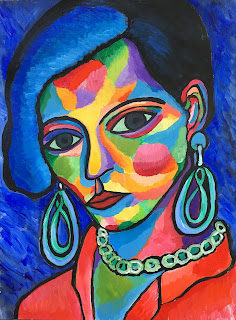 |
| Jawlensky portraits |
I did this project with my adult class last year using acrylics. Students chose magazine portraits and took inspiration from there. We focused on using bright, unmixed colors, painting in blocks, tiles or patches, and allowing for visible brush strokes. To achieve a sense of dimension and form, warm colors were used in more highlighted areas, and cool colors were used in shadowy areas. The results were fabulous!
|
 |
| Adult class. Acrylic |
 |
| Adult class. Acrylic |
I think all kids enjoy drawing themselves - in fact, I would venture to say the inclination to draw oneself is just simply human nature. A portrait assignment, especially one where the results are not meant to be realistic, but rather expressive, bright, bold and daring, suits everyone, even those with drawing inhibitions.
 |
| Teacher sample. Oil pastel and watercolor |
Materials:
Oil pastels
Watercolors
Black permanent marker
Standing mirror
Pencil and eraser
A3 mixed-media paper
See my YouTube video here:
1. Get familiar with Jawlensky’s portrait style. Look at his paintings below. What kind of colors does he use? What type of lines do you see? How does he draw eyes, noses, mouths? Can you see his brushstrokes?
2. Have your materials ready. Set up your mirror at your desk so you can see your face.
3. Follow along to the video and draw your self-portrait. You may pause the video at any time if you need more time. Or, watch the video once, and then begin your portrait afterwards.
*Remember: you are not drawing a REALISTIC self-portrait. You are drawing yourself in the STYLE of Jawlensky. Try to capture your essence – what are some qualities or characteristics that make you unique?
For example, do you have a unique hairstyle? Do you wear huge earrings? Do you have lots of freckles? --- Can you capture this in your drawing?
4. Draw your portrait LARGE in pencil. Start with a LARGE OVAL in the middle of your paper (like an upside down egg) and then add the face features). Jawlensky’s eyes are like large almonds. The nose is a simple ‘L’ shape. The lips are closed.
5. Trace lines with a black permanent marker, if you have one.
6. Color using oil pastels in many bright colors. Maybe you want to try using cool colors in the shadowy areas, and warm colors in the lighter areas of your face. Show texture and ‘visible brush strokes’ when coloring, like Jawlensky does.
7. When finished coloring, trace all contour lines and facial features with a black oil pastel for a strong black outline. This will really make your portrait look like Jawlensky’s!
8. Paint the background in a bright color using watercolors.
 |
| Distance learning results. Oil pastel. Ages 7-10 |


